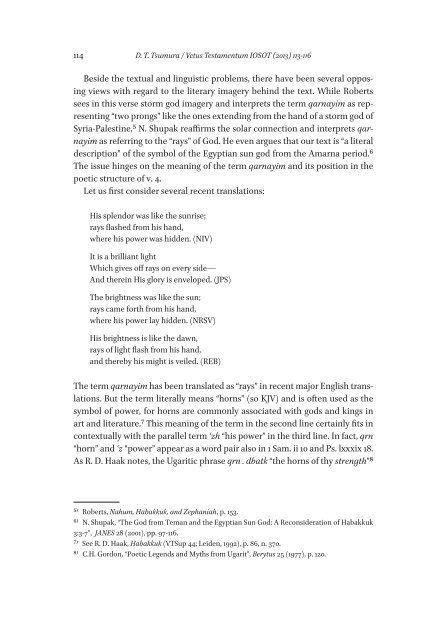Special Issue IOSOT 2013 - Books and Journals
Special Issue IOSOT 2013 - Books and Journals
Special Issue IOSOT 2013 - Books and Journals
You also want an ePaper? Increase the reach of your titles
YUMPU automatically turns print PDFs into web optimized ePapers that Google loves.
114 D. T. Tsumura / Vetus Testamentum <strong>IOSOT</strong> (<strong>2013</strong>) 113-116<br />
Beside the textual <strong>and</strong> linguistic problems, there have been several opposing<br />
views with regard to the literary imagery behind the text. While Roberts<br />
sees in this verse storm god imagery <strong>and</strong> interprets the term qarnayim as representing<br />
“two prongs” like the ones extending from the h<strong>and</strong> of a storm god of<br />
Syria-Palestine,5 N. Shupak reaffirms the solar connection <strong>and</strong> interprets qarnayim<br />
as referring to the “rays” of God. He even argues that our text is “a literal<br />
description” of the symbol of the Egyptian sun god from the Amarna period.6<br />
The issue hinges on the meaning of the term qarnayim <strong>and</strong> its position in the<br />
poetic structure of v. 4.<br />
Let us first consider several recent translations:<br />
His splendor was like the sunrise;<br />
rays flashed from his h<strong>and</strong>,<br />
where his power was hidden. (NIV)<br />
It is a brilliant light<br />
Which gives off rays on every side—<br />
And therein His glory is enveloped. (JPS)<br />
The brightness was like the sun;<br />
rays came forth from his h<strong>and</strong>,<br />
where his power lay hidden. (NRSV)<br />
His brightness is like the dawn,<br />
rays of light flash from his h<strong>and</strong>,<br />
<strong>and</strong> thereby his might is veiled. (REB)<br />
The term qarnayim has been translated as “rays” in recent major English translations.<br />
But the term literally means “horns” (so KJV) <strong>and</strong> is often used as the<br />
symbol of power, for horns are commonly associated with gods <strong>and</strong> kings in<br />
art <strong>and</strong> literature.7 This meaning of the term in the second line certainly fits in<br />
contextually with the parallel term ʿzh “his power” in the third line. In fact, qrn<br />
“horn” <strong>and</strong> ʿz “power” appear as a word pair also in 1 Sam. ii 10 <strong>and</strong> Ps. lxxxix 18.<br />
As R. D. Haak notes, the Ugaritic phrase qrn . dbatk “the horns of thy strength”8<br />
5) Roberts, Nahum, Habakkuk, <strong>and</strong> Zephaniah, p. 153.<br />
6) N. Shupak, “The God from Teman <strong>and</strong> the Egyptian Sun God: A Reconsideration of Habakkuk<br />
3:3-7”, JANES 28 (2001), pp. 97-116.<br />
7) See R. D. Haak, Habakkuk (VTSup 44; Leiden, 1992), p. 86, n. 370.<br />
8) C.H. Gordon, “Poetic Legends <strong>and</strong> Myths from Ugarit”, Berytus 25 (1977), p. 120.








![Am HaSefer [Volk des Buches] - Books and Journals](https://img.yumpu.com/20648352/1/174x260/am-hasefer-volk-des-buches-books-and-journals.jpg?quality=85)







